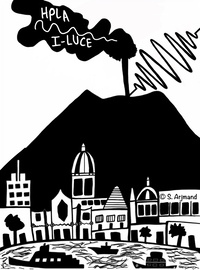Speaker
Description
High peak power laser technology has become over the past decades capable to produce high energy protons in the range of tens of MeV up to 100 MeV. Quite recently a research group has reported significant improvements demonstrating laser-produced 150 MeV protons paving the way for new applications, including some in the medical field like protontherapy today based on equipment like synchrotrons using conventional RF technology.
Here we report on laser technology used for I-LUCE research infrastructure currently under construction at INFN-LNS in Catania and ongoing laser developments of interest for medical applications
To generate high energy protons, it is necessary to focus a laser beam on a solid target to reach a very high intensity, in the range of 10$^{22}$ to 10$^{23}$ W/cm² while keeping a very low intensity level before the main pulse, which can be characterized by the so-called “temporal contrast”.
Chirped Pulse Amplifiers (CPA) based on Titanium Sapphire (TiSa) as active gain medium for laser amplification has been proven over the time as the most effective and most mature technical solution to meet the requirements of high energy protons generation. They can achieve ultrashort pulse duration in the range of 20 to 25 fs being pumped by standard nanosecond laser products and show an energy conversion efficiency which is twice that of OPCPA competing technology which in addition requires customized nanosecond pump lasers.
To achieve high temporal contrast, a specific configuration is used called double CPA. A first TiSa CPA delivers pulses whose energy is in the range of 0.1 to 1 mJ. The output of this first CPA then enters a “XPW” (Crossed Polarised Wave) filter which allows an improvement of the temporal contrast by 4 to 5 orders of magnitude thanks to a 3rd order non linear effect in a suitable crystal. The output light from this XPW filter is then launched in a second CPA which amplifies the energy through several TiSa amplification stages up to typically 12-13 Joule before compression by gratings placed in a vacuum chamber which provide a final output of 8 J in a pulse of 23 fs.
A deformable mirror placed before the compressor allows to compensate the accumulation of wavefront distortion along the laser then leading to minimize laser beam size at the focus and subsequently maximizing the intensity level.
Regarding the current use of TeraWatt and PetaWatt systems, in particular in the case of multi-PetaWatts laser systems, up to 10 PetaWatts, users are generally adding a plasma mirror immediately in front of the solid target in order to be sure to not destroy it. It is a very effective technique to warranty the integrity of the target but in the same time is very lossy as 30 to 40% of the energy is lost when using a double plasma mirror. This is why we have further pushed at Thales the development of front ends with better performance of temporal contrast through the introduction early in the chain of OPCPA stages pumped by picosecond lasers with 2 different configurations, one with an OPCPA pumped at 532 nm by a dedicated pump laser seeded by a narrowband output of the oscillator and another one using a 400 nm pump laser resulting from the frequency doubling of the output of the TiSa regenerative amplifier. These configurations combined with the use of low rugosity optics in the stretcher have allowed a significant improvement of temporal contrast.
Another area of improvement is the repetition rate of the lasers. Recent developments have led to the achievement of 8 TW (200 mJ – 25 fs) pulses at a repetition rate of 100 Hz and the development of a 40 TW (1 J – 25 fs) @ 100 Hz system is underway. In that case the main topic is the huge increase of laser average power needing the implementation of new thermal management solutions compatible with such increase. Two significant developments have been carried out, one on the development of TiSa disks working in the configuration of active mirror amplifiers in order to minimize pump-induced lensing effects in the TiSa crystals, the other one on the active cooling of gold-coated compression gratings in order to limit the heating of gold layers induced by absorption of the laser light by gold.
The increase of laser repetition rate will benefit to many applications in the societal field, like for example the laser-driven generation of VHEE particle beams for cancer therapy where the increase of laser repetition rate will decrease the exposure time of patients.

